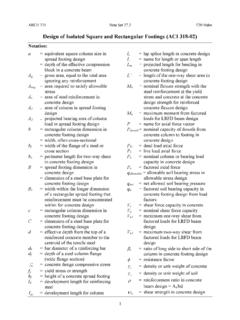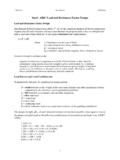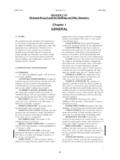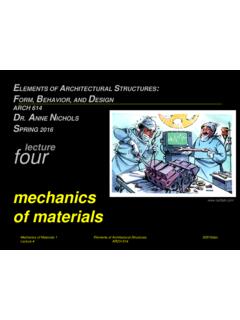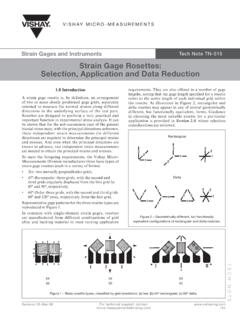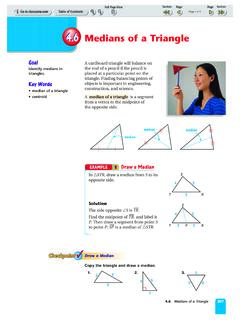Transcription of Centroids & Moments of Inertia of Beam Sections
1 ARCH 614 Note Set 8 S2017abn 139 Centroids & Moments of Inertia of beam Sections Notation: A = name for area b = name for a (base) width C = designation for channel section = name for centroid d = calculus symbol for differentiation = name for a difference = name for a depth dx = difference in the x direction between an area centroid () and the centroid of the composite shape () dy = difference in the y direction between an area centroid () and the centroid of the composite shape () Fz = force component in the z direction h = name for a height = moment of Inertia about the centroid Ic = moment of Inertia about the centroid Ix = moment of Inertia with respect to an x-axis Iy = moment of Inertia with respect to a y-axis Jo = polar moment of Inertia , as is J L = name for length O = name for reference origin Qx = first moment area about an x axis (using y distances)
2 Qy = first moment area about an y axis (using x distances) ro = polar radius of gyration rx = radius of gyration with respect to an x-axis ry = radius of gyration with respect to a y-axis t = name for thickness tf = thickness of a flange tw = thickness of web of wide flange W = name for force due to weight = designation for wide flange section x = horizontal distance = the distance in the x direction from a reference axis to the centroid of a shape = the distance in the x direction from a reference axis to the centroid of a composite shape y = vertical distance = the distance in the y direction from a reference axis to the centroid of a shape = the distance in the y direction from a reference axis to the centroid of a composite shape z = distance perpendicular to x-y plane P = plate symbol = symbol for integration = calculus symbol for small quantity
3 = density of a material (unit weight) = summation symbol The cross section shape and how it resists bending and twisting is important to understanding beam and column behavior. The center of gravity is the location of the equivalent force representing the total weight of a body comprised of particles that each have a mass gravity acts upon. xx yy Ixx yy W1 W4 W2 W3 W y x z L ARCH 614 Note Set 8 S2017abn 140 Resultant force: Over a body of constant thickness in x and y W niizWF1 dWW Location: x, y is the equivalent location of the force W from all Wi s over all x & y locations (with respect to the moment from each force) from: WxWxMniiiy 1 WW xdWxxdWx OR WWxx WyWyMniiix 1 WW ydWyydWy OR WWyy The centroid of an area is the average x and y locations of the area particles For a shape of a uniform thickness and material: iiAtW where: is weight per unit volume (= specific weight) with units of N/m3 or lb/ft3 iAt is the volume So if AWt : xdAxtdAxtxAA OR AAxx and similarly AAyy Similarly, for a line with constant cross section , a (iiLaW ).
4 XdLxL OR LLxx and ydLyL OR LLyy x, y with respect to an x, y coordinate system is the centroid of an area AND the center of gravity for a body of uniform material and thickness. The first moment of the area is like a force moment : and is the area multiplied by the perpendicular distance to an axis. AyydAQx AxxdAQy x y .A y x ARCH 614 Note Set 8 S2017abn 141 Centroids of Common Shapes 3bxb ARCH 614 Note Set 8 S2017abn 142 Symmetric Areas - An area is symmetric with respect to a line when every point on one side is mirrored on the other. The line divides the area into equal parts and the centroid will be on that axis. - An area can be symmetric to a center point when every (x,y) point is matched by a (-x,-y) point. It does not necessarily have an axis of symmetry. The center point is the centroid.
5 - If the symmetry line is on an axis, the centroid location is on that axis (value of 0). With double symmetry, the centroid is at the intersection. - Symmetry can also be defined by areas that match across a line, but are 180 to each other. Basic Steps (Statical moment Method) 1. Draw a reference origin. 2. Divide the area into basic shapes 3. Label the basic shapes (components) 4. Draw a table with headers of Component, Area, x, Ax, y, Ay 5. Fill in the table value 6. Draw a summation line. Sum all the areas, all the Ax terms, and all the Ay terms 7. Calculate x and y Composite Shapes If we have a shape made up of basic shapes that we know centroid locations for, we can find an average centroid of the areas. n1iiin1iiAxAx x A n1iiin1iiAyAy y A Centroid values can be negative. Area values can be negative (holes) xyA1A2A3 ARCH 614 Note Set 8 S2017abn 143 Definition: moment of Inertia ; the second area moment dAxAxIiy22 dAyAyIix22 We can define a single integral using a narrow strip: for Ix,, strip is parallel to x for Iy, strip is parallel to y *I can be negative if the area is negative (a hole or subtraction).
6 A shape that has area at a greater distance away from an axis through its centroid will have a larger value of I. Just like for center of gravity of an area, the moment of Inertia can be determined with respect to any reference axis. Definition: Polar moment of Inertia ; the second area moment using polar coordinate axes dAydAxdArJo222 yxoIIJ Definition: Radius of Gyration; the distance from the moment of Inertia axis for an area at which the entire area could be considered as being concentrated at. ArIxx2 AIrxx radius of gyration in x AIryy radius of gyration in y AJroo polar radius of gyration, and ro2 = rx2 + ry2 pole o r x x x x y x elx dx dA = y dx )(2azIorxx ARCH 614 Note Set 8 S2017abn 144 The Parallel-Axis Theorem The moment of Inertia of an area with respect to any axis not through its centroid is equal to the moment of Inertia of that area with respect to its own parallel centroidal axis plus the product of the area and the square of the distance between the two axes.
7 DAddAyddAydA-dydAyI22222 but0 dAy, because the centroid is on this axis, resulting in: 2 AzIIo (text notation) or 2yxxAdII where Io (or xI) is the moment of Inertia about the centroid of the area about an x axis and dy is the y distance between the parallel axes Similarly 2xyyAdII moment of Inertia about a y axis 2 AdJJco Polar moment of Inertia 222drrco Polar radius of gyration 222drr Radius of gyration * I can be negative again if the area is negative (a hole or subtraction). ** If I is not given in a chart, but y&x are: YOU MUST CALCULATE I WITH 2 AdII Composite Areas: 2 AdII where Iis the moment of Inertia about the centroid of the component area d is the distance from the centroid of the component area to the centroid of the composite area (ie. dy = y -y) Basic Steps 1.
8 Draw a reference origin. 2. Divide the area into basic shapes 3. Label the basic shapes (components) 4. Draw a table with headers of Component, Area, x, Ax, y, Ay, xI, dy, Ady2, yI, dx, Adx2 5. Fill in the table values needed to calculate x and y for the composite 6. Fill in the rest of the table values. 7. Sum the moment of Inertia (I s) and Ad2 columns and add together. axis through centroid at a distance d away from the other axis axis to find moment of Inertia about y A dA A B B y d ARCH 614 Note Set 8 S2017abn 145 Geometric Properties of Areas Area = bh x= b/2 y = h/2 Area = 2bh 3bx 3hy Area = 422dr x= 0 y = 0 Area = 8222dr x= 0 y = 34r Area = 16422dr x= 34r y = 34r Area = ab x= 0 y = 0 Area = 34ah x= 0 y = 53h Area = 3ah x= 43a y = 103h xI= 316ah 175 yI= 34a h 15 xI= 337ah 2100 yI= 3a h 80 xI= yI= 4r8 xI= yI= hbI'y3361 about bottom left xTriangle b about bottom ARCH 614 Note Set 8 S2017abn 146 Example 1 Example 2 A 6 thick concrete wall panel is precast to the dimensions as shown.
9 Using the lower left corner as the reference origin, determine the center of gravity (centroid) of the panel..)in(x.)in(y).(3inAx).(3inAy).()( in5 ARCH 614 Note Set 8 S2017abn 147 Example 3 Find the Moments of Inertia (x = , y = ). Example 4 " y" x1 1 ARCH 614 Note Set 8 S2017abn 148 Example 5 Determine the Moments of Inertia about the centroid of the shape. Solution: There is no reference origin suggested in figure (a), so the bottom left corner is good. In figure (b) area A will be a complete rectangle, while areas C and A are "holes" with negative area and negative moment of inertias. Area A = 200 mm x 100 mm = 20000 mm2 Ix = (200 mm)(100 mm)3/12 = x 106 mm4 Iy = (200 mm)3(100 mm)/12 = x 106 mm4 Area B = - (30 mm)2 = mm2 Ix = Iy = - (30 mm)4/4 = x 106 mm4 Area C = -1/2 (50 mm)2 = mm2 Ix = - (50 mm)4/8 = x 106 mm4 Iy = (50 mm)4= x 106 mm4 Area D = 100 mm x 200 mm x 1/2 = 10000 mm2 Ix = (200 mm)(100 mm)3/36 = x 106 mm4 Iy = (200 mm)3(100 mm)/36 = x 106 mm4 shapeA (mm2) (mm) A (mm3) (mm) A (mm3) shapeIx (mm4)dy (mm)Ady2 (mm4)Iy (mm4)dx (mm)Adx2 (mm4) So, Ix = 19131680 + = 58701918 = x 106 mm4 Ix = 87566466 + = 43572025 = x 106 mm4 o ARCH 614 Note Set 8 S2017abn 149 Example 6 W12x53 12x1 in
